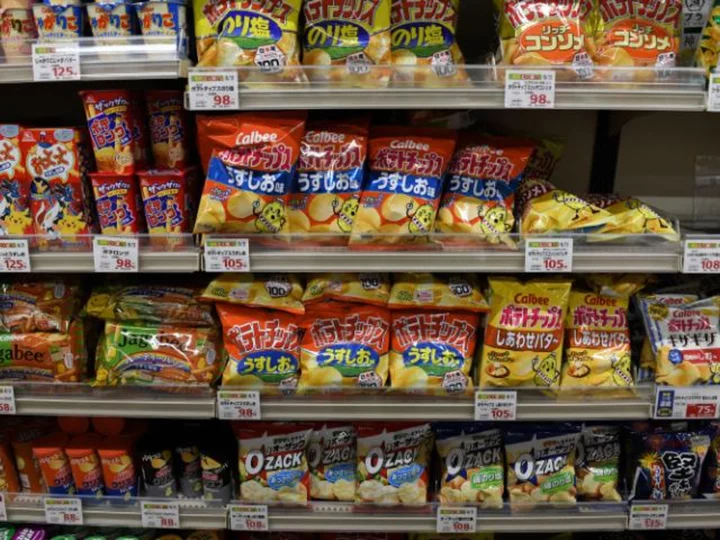What happens when Asia's biggest potato chip maker runs out of potatoes? Japanese snack brand Calbee had to learn the hard way.
Extreme weather disruptions and supply chain snags forced the company to hike prices three times last year and rethink how it sources its most important ingredient.
"That is our headache," Calbee CEO Makoto Ehara told CNN in an interview.
The issue is critical to the company as it embarks on an ambitious $1 billion turnaround and overseas expansion plan that will see it plow deeper into the world's top two economies.
The humble potato is serious business for the 74-year-old snack maker. The Tokyo-based firm uses hundreds of thousands of tons of the vegetable annually to make chips in a variety of flavors, from pizza to soy sauce.
These products rake in hundreds of millions of dollars in sales a year for the company, which posted a profit of 22.2 billion yen ($156 million) in the last fiscal year.
In Asia Pacific, Calbee sells more chips than anyone else besides PepsiCo, its longtime partner that owns about 20% of the company via a subsidiary. Pepsi controls about 24% of the region's potato chip market, while Calbee has about 12%, according to data from Euromonitor International.
Both have been hit over the past two years by ruptures in commodity supplies that led to a record surge in food prices in 2022, affecting virtually everything from tomatoes to rice to peaches.
Experts have called it the worst food crisis in modern history and warned of continued instability ahead, even as the high prices have largely receded.
Supply chain nightmare
Calbee faced a major crisis when it was confronted with a shortage of potatoes from the summer of 2021 to the fall of 2022.
It came against a global backdrop of historically high food prices, as producers grappled with pandemic-related supply chain issues, a historic drought in Brazil and increased global use of vegetable oils, sugar and cereals.
Then the war in Ukraine broke out in February 2022, cutting off access to a critical global grain and vegetable oil exporter.
The crisis contributed to another record jump for food prices last year, with a benchmark index compiled by the United Nations' Food and Agriculture Organization (FAO) reaching its highest annual level since 2005.
Calbee typically sources as much as 90% of its potatoes in Japan, with 80% of that supply coming from Hokkaido, a northern island.
But the area was ravaged by drought in 2021, and the firm's domestic potato supply fell by 8% and 14% in the 2021 and 2022 fiscal years, respectively.
Calbee tried to make up for the shortfall by importing more from the United States, which normally accounts for the remaining 10% of its potato supply. But it didn't have much luck.
A global shortage of shipping containers caused delays and higher prices.
To make matters worse, in late 2021, floods in the US Pacific Northwest stopped ports from operating as usual, making it harder for Calbee to get both potatoes and potato flakes: small, white chunks of dried mashed potatoes used to make Jagarico, its popular line of crispy biscuit sticks.
As a result, the company had to suspend sales promotions and new product launches, while accepting higher procurement and shipping costs. The challenges contributed to a 7% decline in operating profit in the financial year that ended in March 2022.
Looking for solutions
To shore up its supply of potatoes, Calbee is working with farmers across Japan, seeking to boost its domestic supply from 320,000 tons to 400,000 tons a year by the end of the decade.
"Weather is very, very important for us," said Ehara. "So in order to avoid that kind of thing, we are now trying to increase the fields in Japan, other than [in] Hokkaido."
It also estimates it may cut the proportion of potato imports it gets from America, its sole overseas supplier, in half.
The move is "a countermeasure towards the disruption we experienced during the pandemic," said a spokesperson.
To diversify even further, the firm is also considering importing from other markets, such as Europe, according to Ehara.
In May, the FAO index declined to the lowest level in more than a year, with significant price drops "for most cereals, vegetable oils and dairy products," according to the organization. The trend continued in June, before food commodity prices ticked up again in July, highlighting a continued choppiness.
Ehara said prices of potatoes and palm oil had also stabilized.
Steady supplies are vital to the company's ambitious turnaround plan.
Calbee's sales have plateaued in recent years. To address that, the company announced in February it would invest about $1 billion over three years into areas such as automation and overseas expansion.
The company is particularly bullish on prospects in the United States, where it's made inroads with its popular plant-based snack line, Harvest Snaps, which is sold at major chains such as Walmart and Whole Foods.
And in China, it wants to build on traction gained with products like its South Korean-inspired honey butter chips, according to Keiei Sho, managing executive officer for Calbee's overseas businesses.
The company is also bullish on Indonesia, which has a huge young population that could turn into lifelong customers, Sho added.
Emil Fazira, food insights manager in Asia Pacific for Euromonitor, said a "strong supply" of potatoes is especially crucial for the US market.
"The USA alone has a massive market with retail sales volume five [times] larger than the Japanese market," she said, adding the snack business was fiercely competitive, with tight margins and new flavors or brands launched frequently.
"Staying available on shelves is essential, not just to compete with other potato chip brands but also with other types of snacks."

